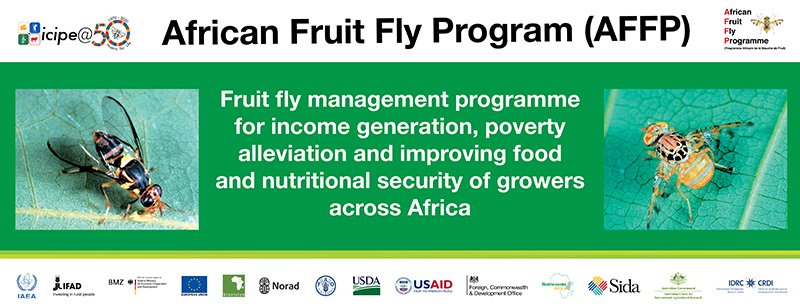Semiochemicals for pre-release treatment of Bactrocera dorsalis and relative response to male lures in semi field conditions: IAEA CRP Simultaneous Application of SIT and MAT to Enhance Management of Bactrocera

Fruits and vegetable production in most African countries is key in generating income, providing sources of nutrition and employment mostly to women and youths who constitute a substantial proportion of people employed in this industry. However, the production of these fruits and vegetables is constrained by several factors, key among them is infestation by fruit flies such as the invasive Bactrocera dorsalis and the native Ceratitis cosyra. Currently in Kenya, the International Centre of Insect Physiology and Ecology (icipe), in collaboration with local and international partners, developed an Integrated Pest Management (IPM) package, aimed at suppressing fruit flies populations in the field (preharvest) and after harvest (postharvest). The package comprises biological control, sanitation, mechanical fruit protection, baiting and male annihilation. These techniques have proven to be amazingly effective but are only being used by individuals at farm level. Thus, a gap exists in which area wide strategies can be incorporated into the already functional IPM package. The current study explores the simultaneous use of Male annihilation and SIT, strategies which could be used as area wide control systems if found to be synergistic. When male annihilation is used concurrently with SIT, sterilized flies are also attracted to the lures, thereby reducing the efficacy of SIT. There is therefore, need to address several factors that should allow the simultaneous application of SIT and MAT to enhance B. dorsalis management. Thus, the objectives of the present study are to establish the relative field response of B. dorsalis to male lures using standardised protocols and to identify alternative semiochemicals which can be fed to sterilized B. dorsalis prior to release in order to reduce attraction to male lures. At the end of the project lifespan, we expect to generate data on B. dorsalis relative response to different lures, alternative semiochemicals which can be incorporated into diet for sterile males before release in order to reduce their response to lures in the field, the ideal age of sterilized flies to be released as well as the standard concentration and quantities of lures to incorporate in insect diet before releasing sterilized flies.
Donor
International Atomic Energy Agency (IAEA)
Partners:
- KALRO-Biotechnology Research Institute Muguga

